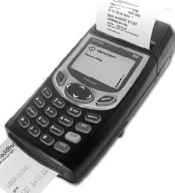Full Brickand Mortar Transactions with Proximity Based Mobile Payment
Some credit card companies are beginning to work with mobile phone manufacturers, to make phones capable of Near Field Communication (NFC) and Radio Frequency Identification (RFID) proximity payment that bills directly to the user's credit card. With this payment model, the mobile phone can be used to pay for any goods and services on the spot, in a brick-and-mortar store, simply by swiping it over a sensor. A chip embedded in the mobile phone simply acts as a relay between the merchant requesting payment and the purchaser's credit card company. Systems like this are not yet common in the United States or Europe, but they are growing in acceptance, especially in Japan and Korea. (As mentioned, NFC and RFID technologies are discussed in more depth in Chapter 6.)
Both the customers and the retailers can benefit from the integration of LBS-style mobile payment. For the customer, it offers the convenience of shopping without having to carry credit cards, cash, or checks. For the retailer, it can streamline the checkout process, creating efficiencies that can even minimize the need for staff at payment registers.
In addition to a traditional brick-and-mortar purchase, this kind of mobile e-commerce can be leveraged by vending machines, street vendors, and even traveling merchants or promoters. In China and Japan, this kind of proximity-based mobile payment is even being used for transportation ticketing and paid-parking situations. In all cases, campaigns that integrate this type of mobile payment will see more success and uptake if they are integrated with other customer touch points that can add value to the transaction. Consider a couple examples where mobile proximity payment can be used.
Retail Locations
When retail locations integrate a proximity-based mobile payment solution with an existing coupon or promotion, they can encourage customers to test the new payment method to participate in the promotion or get the discount. A good example is a store that offers 20% off the final purchase if customers complete the transaction with their RFID- or NFC-enabled phone.
Vending Machines
Using proximity-based mobile payment in vending machines can help both the customer and the vending company. In this instance, mobile payment allows users to make a purchase even when they don't have cash on hand, and it enables vendors to remotely track the levels of stock in each machine. Switching to a mobile payment option also prevents service personnel from having to visit the machine before it is out of stock, simply to remove cash.
Street Vendors, Traveling Merchants, and Promoters
Wireless credit card payment and processing is quite popular in Europe but has not yet become mainstream in the United States. With this technology, service providers can carry a mobile device that can process credit card payments over a cellphone or WiFi signal. For instance, a train attendant could accept payments for train tickets, or waiters could accept payments for meals while walking around with this device. As it grows in popularity, mobile phone payment likely will be integrated with the wireless processing systems.
Figure 12.4 shows a wireless credit card terminal. This device enables a merchant to process credit card information over a cellular network so that it can move around in the course of work and not be tethered by a pay station or an Internet wire. This kind of payment processing can be especially effective for street vendors, traveling merchants, and promoters, but can also be quite useful for plumbers, maids, mechanics, valets, roadside rescue, locksmiths, and other business that require constant mobility.
Figure 12.4 Wireless credit card terminals enable merchants to process credit card information over a cellular network.
Figure 12.4 shows a wireless credit card terminal. This device enables a merchant to process credit card information over a cellular network so that it can move around in the course of work and not be tethered by a pay station or an Internet wire. This kind of payment processing can be especially effective for street vendors, traveling merchants, and promoters, but can also be quite useful for plumbers, maids, mechanics, valets, roadside rescue, locksmiths, and other business that require constant mobility.

In the United States, credit cards use a magnetic strip to communicate with the merchant credit machines, but in Europe, they have transitioned to a system called "chip and PIN." With a chip and PIN payment, the credit card is usually inserted vertically into the payment device and left there for processing, rather than swiping the card as in the United States. The "chip" is an RFID chip that is used to automatically verify information with the card issuer. Figure 12.5 shows several screens from a chip and PIN device.
With any chip and PIN transaction, you are expected to enter a PIN and provide a signature as part of the verification process. Because of this added layer of protection, wireless credit card processing is much more common when a chip and PIN system is present. Instead of taking your credit card away to process when you are paying at a restaurant, waitstaff brings a small wireless processing terminal so that the credit card can be processed directly at the table.
Many companies are working to integrate this type of wireless mobile payment with mobile phones. In this model, a wireless mobile payment terminal could interact directly with a wireless phone through NFC or RFID in much the same way a credit card payment would be processed.
Credit card companies and banks actually tout RFID as a new layer of protection rather than a weakness or opportunity for abuse. Sophisticated RFID payment systems, such as those in chip and PIN credit cards, validate cards by randomly generating unique transaction numbers for each chip, and these change with each transaction. When a transaction is processed, the transaction number on the chip must match the transaction number in the card issuer's database. With this kind of assurance in place, even if thieves had access to a credit card number and an expiration date, they could not complete a transaction.
Travel and Entertainment Ticketing
In 2008, Juniper Research predicted that, by 2013, more than 400 million people in the world will be using mobile ticketing. The major benefit is that when tickets are sold electronically, staff does not need to work at the ticket counter, because tickets can also be delivered directly to
Figure 12.5 Using wireless credit card terminals enables merchants to move around and not be tethered to one location.
the mobile phone. Tickets can be purchased ahead of time, over a mobile Web or SMS payment system, or can be purchased as people enter the venue, when they swipe their phone over a sensor.
Mobile ticketing has seen the highest penetration in East Asia, where Japanese rail travelers and Indian cinema patrons are already purchasing tickets via their mobile phone. Presumably, adoption of this type of mobile commerce in the United States and Europe will follow the same patterns, so travel and transportation will be the first industries to truly embrace mobile ticketing, followed by entertainment and sports.
When mobile tickets are issued, they should include a barcode or redemption code that the attendant can enter directly off the phone at the door or the ticket booth. To make the most of this type of mobile commerce system and improve the user experience, it is incredibly important to give clear directions both on the mobile phone and in the physical area where patrons line up to redeem their tickets. This will help reinforce the efficiency of the process that you need to make mobile ticketing a true success.
The best way to encourage customers to take advantage of a new mobile ticketing program is to loop it in with other incentives or use it to create some efficiency in the customer experience; for example, you could create separate lines for mobile ticket holders, allow people with mobile tickets early entrance, or provide mobile-only coupons or discounts that can be redeemed within the venue.
Parking
Mobile payment can also be used to improve paid-parking opportunities, with or without the presence of a parking attendant. Mobile payment can be integrated in a number of ways, depending on the capability of the phone. Customers can text their parking spot number to a system that sends them a link for online payment. Alternately, customers can be prompted to visit a mobile website where they can enter their parking spot number and credit card information to pay.
Adding functionality to this type of mobile e-commerce is simple and useful for customers. You can send customers information and maps to remind them exactly where their car is parked, in case they can't find it later, or, if the parking spot is metered, the user can add time to the meter over the phone without even having to go back to the car.
Continue reading here: Mobile Strategy Consulting
Was this article helpful?

